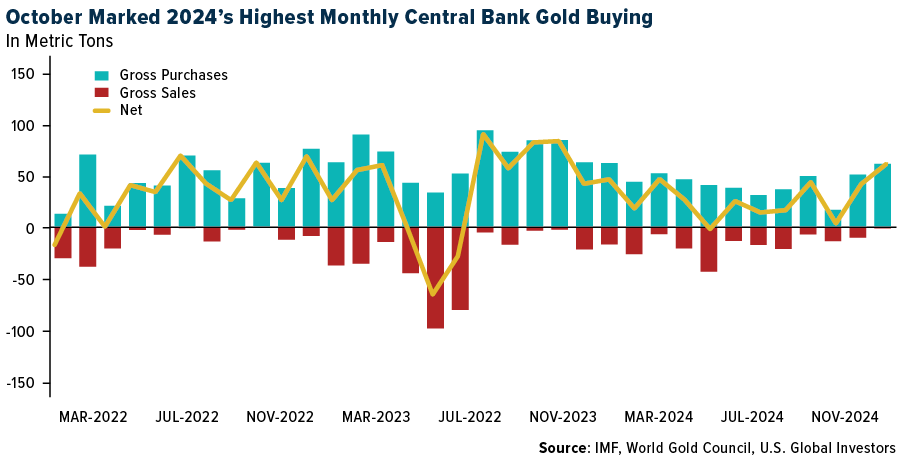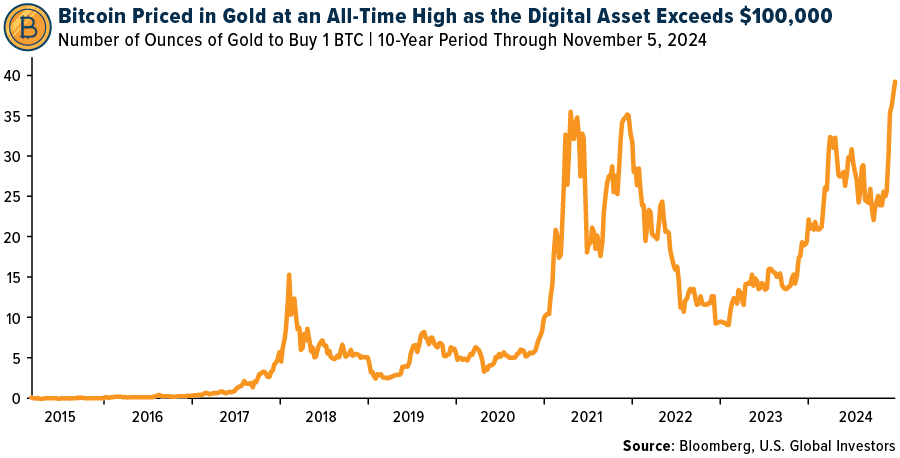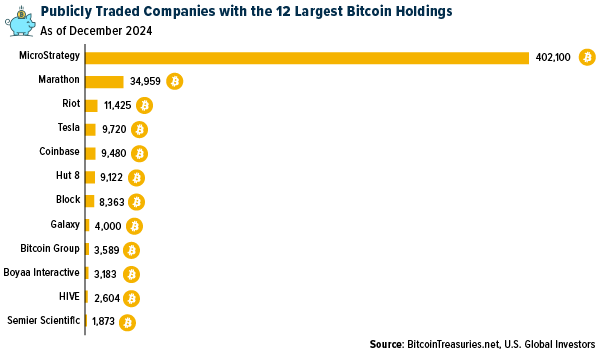Beneath the Surface
Bitcoin’s Rise to $100,000 Signals Global Adoption Shift
December 8, 2024 • 4 minute, 27 second read

~~Frank Holmes, U.S. Global Investors
Just a few short years (months?) ago, few would have believed it possible. But it happened: Bitcoin has traded above $100,000 for the first time ever.
Global adoption of the world’s largest digital asset by market cap is getting harder to ignore. We’re no longer talking about magic internet money favored by tech enthusiasts. We’re talking about a serious financial asset that central banks, corporations and even national governments are now paying close attention to.
Consider the most recent developments: President Nayib Bukele’s El Salvador, the first nation to adopt Bitcoin as legal tender in 2021, has reported more than $333 million in Bitcoin profits.
And here in the U.S., everyone’s talking about the incoming Trump administration’s plans to establish its own strategic Bitcoin reserve.
More Than Digital Gold
Part of Bitcoin’s allure is that it shares many characteristics with gold. This week, Federal Reserve Chairman Jerome Powell said he believes Bitcoin is a competitor to gold rather than the U.S. dollar.
“It’s just like gold, only it’s virtual, it’s digital,” Powell told the audience at the New York Times’s DealBook Summit.
I believe this comparison says a lot. Gold has been a trusted store of value for thousands of years, prized for its scarcity and global liquidity. Central banks just reported buying 60 metric tons of the precious metal in October, the most in a single month this year.

Bitcoin shares these attributes in a modern, digital form. Unlike fiat currencies, there’s a fixed supply of Bitcoin, capped at 21 million coins. That scarcity, combined with growing trust and acceptance, has helped it ascend to this six-figure milestone.
For the record, I don’t believe gold is going anywhere. It’s been around for over 5,000 years and is deeply ingrained in global commerce and traditions. Gold trades over $160 billion every day, second only to the S&P 500, according to the World Gold Council (WGC). Plus, unlike Bitcoin, gold has many practical use cases, from jewelry to electronics.
But Bitcoin is carving out its own path, proving it can also serve as a store of value in turbulent times. The chart below shows the Bitcoin-to-gold ratio, which tells you how many ounces of gold it takes to buy one Bitcoin. This week, the ratio surpassed 38, a new all-time high.

Political Winds Shifting in Bitcoin’s Favor
It’s not just Wall Street that is warming to Bitcoin. The political climate appears to be shifting as well.
President-elect Donald Trump—a former crypto skeptic turned fan—recently nominated Paul Atkins, a conservative and crypto-friendly lawyer, to replace Gary Gensler as the head of the Securities and Exchange Commission (SEC). During his tenure at the SEC from 2002 to 2008, Atkins fought for balanced, innovation-friendly policies. His return could pave the way for more regulatory clarity, attracting even more institutional capital into the crypto space.
Trump also just named billionaire venture capitalist David Sacks as his “AI and crypto czar.” Sacks, a member of the so-called PayPal Mafia, is another strong advocate for clear regulations in cryptocurrency and artificial intelligence. His leadership, I believe, could help position the U.S. as a global leader in emerging technologies, including Bitcoin, blockchain and AI.
And on Capitol Hill, Senator Cynthia Lummis of Wyoming, a longtime Bitcoin advocate, has proposed the BITCOIN Act, which, if passed, would lead to the creation of a U.S. strategic Bitcoin reserve. Just as the Strategic Petroleum Reserve (SPR) ensures a steady supply of oil in times of emergency, a Bitcoin reserve could serve as a digital financial backstop, a buffer against economic shocks and runaway inflation.
Analysts’ Forecasts Turn (Even More) Bullish
Major financial institutions and research firms aren’t sitting idle. Bernstein Private Wealth Management projects Bitcoin could reach $200,000 by late 2025, a forecast echoed by Standard Chartered.
One of the key drivers of these higher forecasts is the inflow of institutional money. Big investors—corporations, pension funds, endowments—are starting to treat Bitcoin as a legitimate part of a diversified portfolio. According to analysts, if U.S. retirement funds or a proposed U.S. strategic Bitcoin reserve started accumulating even a small percentage of their assets in Bitcoin, demand could skyrocket.
MicroStrategy, a publicly traded company, has shown leadership in this area. Its aggressive three-year Bitcoin purchasing plan has already exceeded expectations. Its strategy? Treat Bitcoin like a corporate treasury reserve asset.

Allocate Responsibly
So, what does all this mean for investors?
First, it means that Bitcoin is no longer a fringe phenomenon. At over $100,000 per coin, it’s a force to be reckoned with, attracting serious interest from global institutions and governments.
That said, investing in Bitcoin should still be approached thoughtfully. Volatility remains high. While gold typically moves at a measured pace, Bitcoin’s price can swing more dramatically. Proper allocation could provide exposure to Bitcoin’s growth potential without taking on excessive risk.
As regulators become more crypto-friendly, and as the U.S. government considers strategic reserves, Bitcoin’s credibility and staying power have only grown. This isn’t to say Bitcoin will replace gold overnight or that it comes without risks. But after crossing the psychologically important $100,000 mark, it’s clear that the world’s largest cryptocurrency is maturing into a bona fide financial instrument worthy of consideration.



